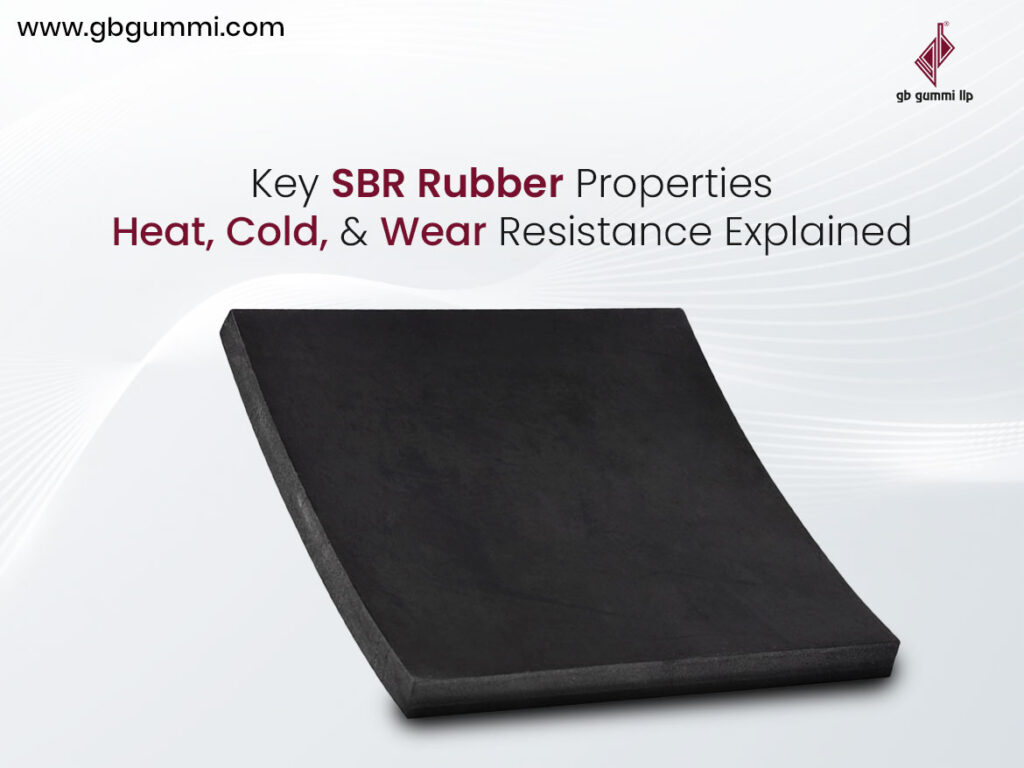Rubber’s everywhere in industry — tyres, hoses, gaskets, seals, you name it. But not all rubber is created equal. One type that keeps popping up again and again is Styrene Butadiene Rubber, or SBR. It’s basically the workhorse of synthetic rubbers: flexible, tough, and reliable in a bunch of different situations.Automotive, construction, general engineering — SBR finds a way in all of them. Why? Its co
mbination of abrasion resistance, temperature stability, and overall durability makes it kind of a no-brainer for manufacturers. Let’s break down why SBR keeps earning trust.
A Quick Intro to SBR
SBR is made by copolymerizing styrene and butadiene. Sounds fancy, but the point is it was designed to give us something like natural rubber, just more uniform and cheaper to produce at scale.
Natural rubber is great — elastic, bouncy, proven. But SBR is easier to control. You get consistent quality batch after batch, better ageing resistance, and a price point that makes large-scale production feasible. Modern SBR compounds are tuned carefully by chemists to handle specific temperatures, stress, and flexibility needs, making them versatile for a ton of industrial uses.
High Temperature Resistance
One of the standout things about SBR is that it keeps its cool — or rather, keeps its shape — under heat. Standard SBR can usually take around 100°C continuously, and there are special heat-resistant versions that can go even higher.
Think tyres, conveyor belts, or industrial seals. Even with frictional heat or extended sun exposure, SBR won’t just sag or lose elasticity. That means fewer failures, less downtime, and a longer life for products. Compared to some natural rubber alternatives, it’s just more dependable when temperatures rise.
Flexibility in the Cold
But what about freezing conditions? Rubber often gets brittle when it’s cold. Not SBR. Certain formulations can stay flexible down to -40°C. That makes it perfect for seals, hoses, or any application that sees extreme cold — cold storage, refrigerated transport, you get the idea.
Adjust the compound a little, and you can fine-tune how soft or springy it stays at low temperatures. No cracking, no brittleness — just consistent performance.
Durability Under Stress
SBR is tough under pressure, literally. Repeated compression, stretching, friction — it can take it all. Tyres, flooring, vibration mounts, industrial mats — SBR holds up.
Its molecular structure distributes stress evenly, so it doesn’t deform or tear easily. When reinforced with fillers and stabilizers, it can match the durability of more expensive elastomers but at a fraction of the cost. That’s why it’s so popular with manufacturers looking for cost-effective longevity.
Resistance to Ageing
Natural rubber can degrade over time — oxygen, ozone, UV light, all that. SBR? It resists it. Its synthetic makeup, often combined with antioxidants and anti-ozonants, keeps it from hardening, cracking, or losing elasticity.
Outdoor components, high-UV exposure, long-term use — SBR just keeps going. This stability is one of the reasons so many rubber compound manufacturers in India rely on it for industrial sheets, gaskets, and other tough applications.
Chemical Resistance
SBR isn’t invincible, but it handles a fair amount of chemicals. Alcohol, water, weak acids — generally fine. Strong oils or hydrocarbons? Better to go with nitrile or EPDM. But for general-purpose environments, SBR is a solid, economical choice.
Some manufacturers even tweak the formulation with natural rubber vulcanisation techniques to improve chemical resistance without sacrificing elasticity. That’s flexibility, literally and figuratively.
Consistent Performance
The biggest selling point? Predictability. Because it’s synthetically made, every batch behaves the same. Natural rubber varies depending on the tree it came from, climate, and processing — SBR doesn’t.
That consistency is a lifesaver for engineers who need hundreds or thousands of identical components. It’s also easy to process, mix, and mold, which helps manufacturers scale up without unexpected hiccups. Sheets, seals, molded parts — SBR makes them all perform reliably.
Where SBR Really Shines
Industries that lean on SBR include:
- Automotive: Tyres, hoses, seals, brake components — anything that faces friction and heat.
- Construction: Vibration pads, flooring, expansion joints.
- Industrial: Conveyor belts, gaskets, linings.
It’s affordable, tough, and versatile. Often, SBR is even blended with natural or nitrile rubber to tweak performance for specific needs — heat, flexibility, or abrasion resistance.
SBR rubber earns its reputation because it’s reliable, versatile, and cost-effective. High-heat tolerance, cold-weather flexibility, long-term durability — it balances all of these better than most alternatives.
And with modern formulations and natural rubber vulcanization techniques, it’s only getting better. Manufacturers looking for consistent, high-quality products, especially in India, know that partnering with experienced rubber compound makers like GB Gummi pays off. Their compounds perform as promised, whatever the conditions.

